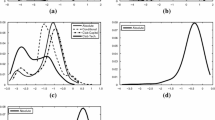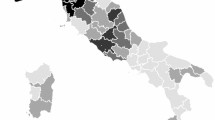Abstract
Evolving Geographical Concentration of European Manufacturing Industries. — This paper analyzes the geographical concentration of 32 manufacturing sectors over the 1972–1996 period for 13 European countries. Concentration has increased continuously over the sample period in employment terms, while remaining roughly unchanged in export terms. On average, increases in concentration were stronger prior to the launch of the Single Market than afterwards. The sectors most sensitive to the Single Market however, showed an acceleration in concentration after 1986. There is also evidence that low-tech industries are the most strongly concentrated, and that center-periphery gradients across countries are losing importance for industrial location in the EU.
Similar content being viewed by others
References
Amiti, M. (1999). Specialization Patterns in Europe.Weltwirtschaftliches Archiv 135 (4): 573–593.
Brülhart, M. (1998). Trading Places: Industrial Specialization in the European Union.Journal of Common Market Studies 36 (3): 319–346.
— (2001). Growing Alike or Growing Apart? Industrial Specialization of EU Countries. In C. Wyplosz (ed.),EMU and Its Impact on Europe and Developing Countries. Oxford: Oxford University Press, forthcoming.
Brülhart, M., and R. Elliott (1998). Adjustment to the European Single Market: Inferences from Intra-Industry Trade Patterns.Journal of Economic Studies 25 (3): 225–247.
Brülhart, M., and J. Torstensson (1996). Regional Integration, Scale Economies and Industry Location in the European Union. CEPR Discussion Paper 1435. London.
Buigues, P., F. Ilzkovitz, and J.-F. Lebrun (1990). The Impact of the Internal Market by Industrial Sector: The Challenge for the Member States’. In Commission of European Communities, The European Economy — Social Europe (Special Ed.). Brussels.
Cowell, F. A. (2000). Measurement of Inequality. In F. Bourguignon and A. B. Atkinson (eds.),Handbook of Income Distribution. Amsterdam: North-Holland.
Davis, D. R. (1998). The Home Market, Trade and Industrial Structure.American Economic Review 88 (5): 1264–1276.
Davis, D. R., and D. E. Weinstein (1996). Does Economic Geography Matter for International Specialization? NBER Working Paper 5706. Cambridge, Mass.
De Nardis, S., A. Goglio, and M. Malgarini (1996). Regional Specialization and Shocks in Europe: Some Evidence from Regional Data.Weltwirtschaftliches Archiv 132 (2): 197–214.
Ellison, G., and E. L. Glaeser (1997). Geographic Concentration in United States Manufacturing Industries: A Dartboard Approach.Journal of Political Economy 105 (5): 889–927.
Emerson, M., M. Aujean, M. Catinat, P. Goybet, and A. Jacquemin (1988).The Economics of 1992: The EC Commission’s Assessment of the Economic Effects of Completing the Internal Market. Oxford: Oxford University Press.
Feenstra, R. C., J. A. Markusen, and A. K. Rose (2001). Using the Gravity Equation to Differentiate Among Alternative Theories of Trade.Canadian Journal of Economics, forthcoming.
Fontagn’e, L., M. Freudenberg, and N. P’eridy (1997). Trade Patterns Inside the Single Market. CEPII, Document de travail 97-07. Paris.
Fujita, M., P. Krugman, and A. Venables (1999).The Spatial Economy: Cities, Regions and International Trade. Cambridge, Mass.: MIT Press.
Harris, C. D. (1954). The Market as a Factor in the Localization of Industry in the United States.Annals of the Association of American Geographers 44 (4): 156–198.
Head, K., and J. Ries (2001). Increasing Returns Versus National Product Differentiation as an Explanation of US-Canada Trade.American Economic Review, forthcoming.
Helg, R., P. Manasse, T. Monocelli, and R. Rovelli (1995). How Much (A)symmetry in Europe? Evidence from Industrial Sectors.European Economic Review 39 (5): 1017–1041.
Helpman, E., and P. Krugman (1985).Market Structure and Foreign Trade. Cambridge, Mass.: MIT Press.
Kim, S. (1995). Expansion of Markets and the Geographic Distribution of Economic Activities: The Trends in United States Regional Manufacturing Structure, 1860–1987.Quarterly Journal of Economics 110 (4): 881–908.
Krugman, P. (1980). Scale Economies, Product Differentiation, and the Pattern of Trade.American Economic Review 70 (5): 950–959.
— (1991).Geography and Trade. Cambridge, Mass.: MIT Press.
— (1993). First Nature, Second Nature, and Metropolitan Location.Journal of Regional Science 33 (2): 129–144.
Leamer, E. E. (1997). Access to Western Markets and Eastern Effort Levels. In S. Zecchini (ed.),Lessons from the Economic Transition. Boston: Kluwer.
Learner, E. E., and J. Levinsohn (1995). International Trade Theory: The Evidence. In G. Grossmann and K. Rogoff (eds.),Handbook of International Economics. Vol. 3. New York: Elsevier.
LundbÄck, E., and J. Torstensson (1998). Demand, Comparative Advantage and Economic Geography in International Trade: Evidence from the OECD.Weltwirtschaftliches Archiv 134 (2): 230–249.
OECD (1987).Structural Adjustment and Economic Performance. Paris: OECD.
— (1994).The OECD Jobs Study. Part I:Labour Market Trends and Underlying Forces of Change. Paris: OECD.
— (1999)The OECD STAN Database for Industrial Analysis, 1978–1997. Paris: OECDt.
Pratten, C. (1988). A Survey of the Economies of Scale. In: Commission of the European Communities,Research on the “Cost of Non-Europe”. Vol. 2:Studies on the Economics of Integration. Luxembourg.
Redding, S. (1999). The Dynamics of International Specialization. CEPR Discussion Paper 2287. London.
Ruhashyankiko, J.-F. (2000). How Is the World Specialising? London School of Economics. Mimeo.
Sapir, A. (1996). The Effects of Europe’s Internal Market Programme on Production and Trade: A First Assessment.Weltwirtschaftliches Archiv 132 (3): 457–475.




